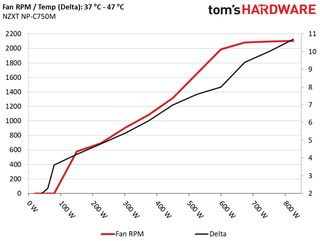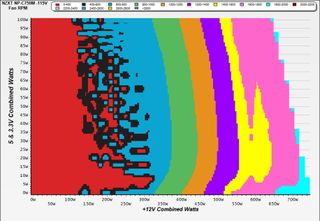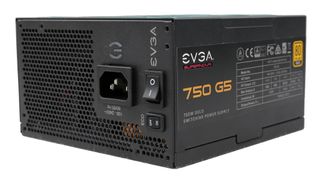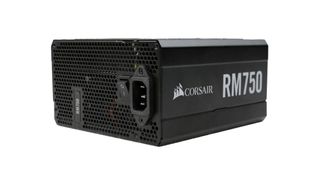Why you can trust Tom's Hardware
To learn more about our PSU tests and methodology, please check out How We Test Power Supply Units.
Primary Rails And 5VSB Load Regulation
The following charts show the main rails' voltage values recorded between a range of 40W up to the PSU's maximum specified load, along with the deviation (in percent). Tight regulation is an important consideration every time we review a power supply because it facilitates constant voltage levels despite varying loads. Tight load regulation also, among other factors, improves the system’s stability, especially under overclocked conditions and, at the same time, it applies less stress to the DC-DC converters that many system components utilize.

Results 1-8: Load Regulation







Load regulation is tight at 12V, but not that tight on the minor rails.
Hold-Up Time
Put simply; hold-up time is the amount of time that the system can continue to run without shutting down or rebooting during a power interruption.

Results 9-12: Hold-Up Time






The hold-up time is long and the power ok signal is accurate, so everything is good here.
Inrush Current
Inrush current, or switch-on surge, refers to the maximum, instantaneous input current drawn by an electrical device when it is first turned on. A large enough inrush current can cause circuit breakers and fuses to trip. It can also damage switches, relays, and bridge rectifiers. As a result, the lower the inrush current of a PSU right as it is turned on, the better.

Results 13-14: Inrush Current

The inrush currents stay at low levels, with both voltage inputs.
10-110% Load Tests
These tests reveal the C750's load regulation and efficiency levels under high ambient temperatures. They also show how the fan speed profile behaves under increased operating temperatures.
| Test # | 12V | 5V | 3.3V | 5VSB | DC/AC (Watts) | Efficiency | Fan Speed (RPM) | PSU Noise (dB[A]) | Temps (In/Out) | PF/AC Volts |
| 1 | 4.421A | 1.988A | 1.982A | 0.982A | 74.962 | 86.060% | 0 | <6.0 | 43.25°C | 0.963 |
| 12.070V | 5.030V | 3.331V | 5.091V | 87.104 | 39.63°C | 115.15V | ||||
| 2 | 9.872A | 2.986A | 2.975A | 1.182A | 150.035 | 89.637% | 577 | 10.5 | 40.96°C | 0.979 |
| 12.068V | 5.024V | 3.327V | 5.077V | 167.380 | 45.12°C | 115.13V | ||||
| 3 | 15.662A | 3.489A | 3.477A | 1.383A | 225.038 | 90.437% | 691 | 14.4 | 41.06°C | 0.985 |
| 12.066V | 5.018V | 3.322V | 5.063V | 248.834 | 45.89°C | 115.12V | ||||
| 4 | 21.459A | 3.992A | 3.979A | 1.585A | 300.049 | 90.458% | 903 | 22.2 | 41.78°C | 0.986 |
| 12.062V | 5.011V | 3.318V | 5.050V | 331.699 | 47.22°C | 115.09V | ||||
| 5 | 26.881A | 4.997A | 4.979A | 1.788A | 374.662 | 90.144% | 1087 | 28.1 | 42.03°C | 0.988 |
| 12.059V | 5.004V | 3.313V | 5.036V | 415.624 | 48.10°C | 115.11V | ||||
| 6 | 32.333A | 6.004A | 5.986A | 1.992A | 449.612 | 89.570% | 1316 | 33.7 | 42.29°C | 0.988 |
| 12.056V | 4.997V | 3.308V | 5.021V | 501.965 | 49.25°C | 115.11V | ||||
| 7 | 37.821A | 7.017A | 6.993A | 2.198A | 524.934 | 88.902% | 1654 | 39.3 | 43.06°C | 0.989 |
| 12.052V | 4.989V | 3.304V | 5.006V | 590.462 | 50.69°C | 115.10V | ||||
| 8 | 43.310A | 8.003A | 8.000A | 2.405A | 600.105 | 88.138% | 1988 | 43.6 | 44.27°C | 0.990 |
| 12.049V | 4.981V | 3.300V | 4.990V | 680.873 | 52.28°C | 115.09V | ||||
| 9 | 49.172A | 8.545A | 8.497A | 2.410A | 674.779 | 87.440% | 2081 | 44.6 | 44.37°C | 0.990 |
| 12.045V | 4.973V | 3.296V | 4.980V | 771.705 | 53.74°C | 115.08V | ||||
| 10 | 54.836A | 9.066A | 9.032A | 3.027A | 750.005 | 86.604% | 2094 | 44.7 | 45.22°C | 0.991 |
| 12.041V | 4.965V | 3.289V | 4.957V | 866.012 | 55.17°C | 115.08V | ||||
| 11 | 61.100A | 9.082A | 9.056A | 3.033A | 825.239 | 85.700% | 2104 | 44.9 | 46.51°C | 0.992 |
| 12.038V | 4.956V | 3.280V | 4.947V | 962.936 | 57.17°C | 115.07V | ||||
| CL1 | 0.117A | 12.001A | 12.001A | 0.000A | 101.657 | 84.856% | 794 | 18.4 | 42.21°C | 0.972 |
| 12.079V | 5.017V | 3.336V | 5.088V | 119.799 | 47.85°C | 115.16V | ||||
| CL2 | 62.019A | 1.000A | 1.000A | 1.000A | 759.915 | 87.085% | 2096 | 44.8 | 45.47°C | 0.991 |
| 12.039V | 4.971V | 3.280V | 5.018V | 872.613 | 55.83°C | 115.08V |
The PSU can deliver full power at high operating temperatures without any issues. Naturally, efficiency takes a notable hit under harsh conditions, and it cannot reach 87% at full load, dropping below 86% during the overload test.
20-80W Load Tests
In the following tests, we measure the C750's efficiency at loads significantly lower than 10% of its maximum capacity (the lowest load the 80 Plus standard measures). This is important for representing when a PC is idle with power-saving features turned on.
| Test # | 12V | 5V | 3.3V | 5VSB | DC/AC (Watts) | Efficiency | Fan Speed (RPM) | PSU Noise (dB[A]) | PF/AC Volts |
| 1 | 1.230A | 0.496A | 0.495A | 0.196A | 19.992 | 70.086% | 0 | <6.0 | 0.850 |
| 12.067V | 5.036V | 3.332V | 5.117V | 28.525 | 115.16V | ||||
| 2 | 2.459A | 0.994A | 0.991A | 0.392A | 39.982 | 80.502% | 0 | <6.0 | 0.929 |
| 12.067V | 5.035V | 3.332V | 5.109V | 49.666 | 115.16V | ||||
| 3 | 3.693A | 1.490A | 1.485A | 0.588A | 60.012 | 84.673% | 0 | <6.0 | 0.953 |
| 12.068V | 5.032V | 3.331V | 5.102V | 70.875 | 115.15V | ||||
| 4 | 4.919A | 1.987A | 1.982A | 0.785A | 79.961 | 86.795% | 0 | <6.0 | 0.964 |
| 12.068V | 5.031V | 3.331V | 5.095V | 92.126 | 115.15V |
At light loads, there is no need for the fan to spin if the semi-passive mode is enabled.
2% or 10W Load Test
Intel plans on raising the ante at efficiency levels under ultra-light loads. So from July 2020, the ATX spec will require 70% and higher efficiency with 115V input. The applied load is only 10W for PSUs with 500W and lower capacities, while for stronger units we dial 2% of their max-rated-capacity.
| Test # | 12V | 5V | 3.3V | 5VSB | DC/AC (Watts) | Efficiency | Fan Speed (RPM) | PSU Noise (dB[A]) | PF/AC Volts |
| 1 | 1.080A | 0.212A | 0.208A | 0.052A | 15.053 | 64.017% | 0 | <6.0 | 0.799 |
| 12.062V | 5.038V | 3.330V | 5.121V | 23.514 | 115.16V |
With 2% of its max-rated-capacity load, efficiency is above 60%, but it cannot reach the 70% mark.
Efficiency
Next, we plotted a chart showing the C750’s efficiency at low loads, and loads from 10 to 110% of its maximum-rated capacity. The higher a PSU’s efficiency, the less energy goes wasted, leading to a reduced carbon footprint and lower electricity bills.

Results 15-18: Efficiency




The platform performs decently when it comes to efficiency, especially in the 20-80W load range.
5VSB Efficiency
| Test # | 5VSB | DC/AC (Watts) | Efficiency | PF/AC Volts |
| 1 | 0.100A | 0.512 | 74.096% | 0.106 |
| 5.122V | 0.691 | 115.17V | ||
| 2 | 0.250A | 1.280 | 76.647% | 0.219 |
| 5.119V | 1.670 | 115.17V | ||
| 3 | 0.550A | 2.813 | 77.621% | 0.335 |
| 5.112V | 3.624 | 115.17V | ||
| 4 | 1.000A | 5.104 | 77.498% | 0.407 |
| 5.103V | 6.586 | 115.17V | ||
| 5 | 1.500A | 7.639 | 77.846% | 0.442 |
| 5.091V | 9.813 | 115.17V | ||
| 6 | 3.000A | 15.159 | 76.272% | 0.494 |
| 5.053V | 19.875 | 115.17V |

Results 19-20: 5VSB Efficiency

Close enough to the competition, but we would like to see more from Seasonic in this rail.
Power Consumption In Idle And Standby
| Mode | 12V | 5V | 3.3V | 5VSB | Watts | PF/AC Volts |
| Idle | 12.062V | 5.040V | 3.331V | 5.124V | 7.744 | 0.489 |
| 115.2V | ||||||
| Standby | 0.044 | 0.007 | ||||
| 115.2V |

Results 21-22: Vampire Power

The PSU's energy needs at standby mode are low.
Fan RPM, Delta Temperature, And Output Noise
All results are obtained between an ambient temperature of 37 to 47 degrees Celsius (98.6 to 116.6 degrees Fahrenheit).


The fan speed profile is quite aggressive overall, especially under high operating temperatures.
The following results were obtained at 30 to 32 degrees Celsius (86 to 89.6 degrees Fahrenheit) ambient temperature.


Up to 450W loads, the PSU's noise doesn't exceed 30 dBA, so it is fairly quiet. With higher than 500W loads, it enters the 35-40 dBA zone so it will make its presence felt, while with more than 560W loads, noise output exceeds 40 dBA, which can be annoying.
MORE: Best Power Supplies
MORE: How We Test Power Supplies
MORE: All Power Supply Content
Current page: Load Regulation, Hold-Up Time, Inrush Current, Efficiency and Noise
Prev Page Specifications and Part Analysis Next Page Protection Features, Leakage Current, DC Power Sequencing, Cross-Load Tests and Infrared ImagesAris Mpitziopoulos is a Contributing Editor at Tom's Hardware US, covering PSUs.
-
Avro Arrow Nice-looking PSU. The only problem is that these days, people don't know which way to turn with all of these re-branded PSUs. As you stated, this is the same as the SeaSonic, which makes it good, but there are so many good PSUs that the market is just saturated. Names like EVGA, Antec, Corsair, and Be Quiet! are all top-tier and well-respected names.Reply
Then in the second tier you get names like Cooler Master, Thermaltake, Gigabyte and ASUS. This NZXT could easily get lost in the mix. -
E-Bert a bit late but a question about the noise level, it says 33 decibels average across usage, but if im only using say 550W max load is it ever going to hit that 33 decibels? its the only thing stopping me from picking one up at the momentReply



